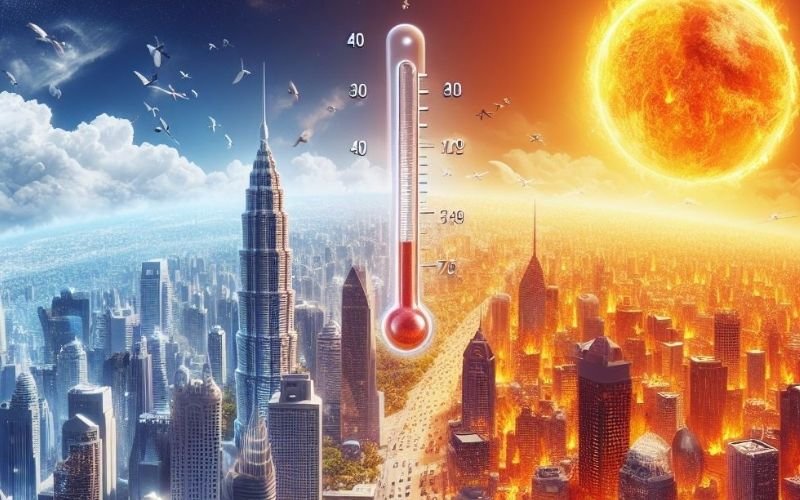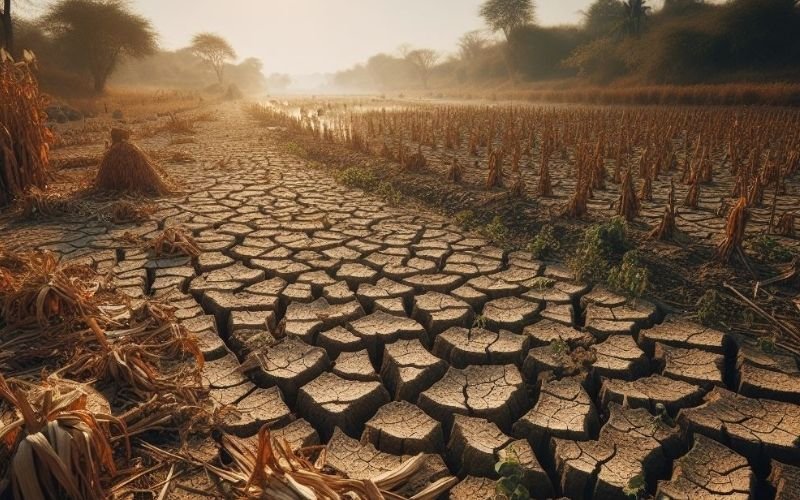Summer in India is getting hotter every year, and it’s not just a feeling – it’s a fact. Last year was the hottest on record, making the scorching temperatures more than just uncomfortable.
In 2021, the scorching heat led to a loss of money equivalent to 5.4% of India’s economy. To put it simply, that’s a whopping $159 billion lost.
But it’s not just about the money. Extreme heat isn’t just an inconvenience; it’s a serious health risk. In 2023, 252 people lost their lives due to the blistering temperatures.
Experts warn that this rising temperature trend isn’t just a local issue; it’s a global problem that only worsens.
So, Why Is It So Hot This Summer in India? In this blog post, we’ll dive into the causes behind India’s sweltering heat, explore its effects, and discuss potential solutions.
Why Is It So Hot This Summer in India?

Despite being close to the Equator, India usually sees scorching summers with temperatures ranging from 32 to 40 °C. However, in recent years, including this one, the heat has intensified, especially in states like Odisha, Andhra Pradesh, Telangana, and West Bengal, where temperatures have soared to alarming levels of 41 and 46 °C. This surge in heat isn’t just a fluke of nature; it’s largely attributed to human activities, particularly climate change.
The Indian Meteorological Department (IMD) has raised the alarm, issuing warnings about the heatwave. During such extreme conditions, staying indoors and avoiding strenuous outdoor activities is advisable.
The repercussions of this heat surge, driven by climate change, are far-reaching, impacting various sectors like agriculture, economy, and construction.
Now, let’s break down why climate change is the primary culprit behind the rising temperatures.
Climate Change is the Biggest Culprit
When certain gases, like carbon dioxide and methane, build up in our planet’s atmosphere, they act like a cozy blanket, trapping heat from the Sun. This creates what we call the Greenhouse Gas Effect. As more of these gases pile up, Earth’s temperature rises like a thermometer on a hot day.
Now, climate change isn’t new; it’s been happening gradually over millions of years. But what’s speeding it up today are human activities, mainly from two big sources: the energy sector (think coal, oil, and natural gas) and the animal industry. Together, these account for a whopping 87% (Energy Sector: 73% & Animal Industry: 14%) of the greenhouse gases we emit.
Just three countries—China: 33%, the United States: 13%, and India: 7% —churn out over 53% of greenhouse gas emissions.
Since we started the Industrial Revolution, Earth’s temperature has gone up by 1.1 °C. In 2023, it reached 1.5 °C, marking a significant point not witnessed in over 100,000 years.
Today, the level of carbon dioxide in our atmosphere is around 420 parts per million (PPM). That’s a staggering 50% increase from before we started messing with industrial activities. To find a time when CO2 levels were this high, you’d have to rewind the clock back some 26 million years.
Imagine Earth as a giant greenhouse, where the more greenhouse gases we release, the hotter it gets inside. This extra heat messes with our weather, making extreme heat waves a regular thing worldwide. This change in temperature messes with everything from the air we breathe to the food we eat.
Heat Waves and Their Impact
According to the World Health Organization (WHO), when the temperature in flat areas hits 40°C or higher, or in hilly spots reaches 30°C or more, we’re officially in the fiery grip of a heat wave.
Impact on Farming

The heat blasts our crops, making them wither away. In 2022, places like Punjab, Haryana, and Uttar Pradesh saw a big drop—between 10% to 35%—in wheat production because of scorching temperatures. And it’s not just the heat; the lack of rain turns fertile lands into dusty deserts, leaving farmers high and dry.
A rise in the Earth’s average temperature by just 1°C would lead to a 6% drop in wheat harvests and a 10% decrease in rice yields worldwide. Similarly, hotter temperatures could slash maize production by a whopping 80-90%. With less of these essential grains available, their prices are likely to shoot up.
Health Hazards

Being stuck in sweltering heat for too long causes heat stress—our bodies struggle to keep cool. It leads to sweating buckets, feeling dizzy, and even getting sick to our stomachs.
During heat waves, certain groups of people can experience heat stress. This includes older adults, children, outdoor workers (such as those in construction, manufacturing, and farming), and individuals dealing with long-term health issues. These individuals are particularly vulnerable to health problems when temperatures rise.
And then there’s heat stroke, a dangerous condition where our bodies can’t cool down fast enough. It can damage our organs, knock us into a coma, or worse—take our lives. In places like Uttar Pradesh, Bihar, and Delhi, temperatures hit a staggering 47°C in March 2023, leading to hundreds of deaths from heat stress.
Over the past two decades, around 10,000 people in India have lost their lives due to heat-related issues. That’s a shocking 34% jump in death rates.
Economic Fallout

The heat doesn’t just mess with our bodies—it messes with our wallets too.
Imagine trying to work outside when it feels like you’re baking in an oven. It’s no wonder people in construction, manufacturing, and farming struggle to keep up. The heat saps their energy, making it tough to get the job done.
In 2021 alone, India lost a whopping 167.2 billion hours of work due to extreme heat. And if things don’t change, experts predict a 4.5% drop in India’s GDP by 2030—all thanks to scorching temperatures.
Plus, as everyone cranks up their ACs to escape the heat, the demand for electricity skyrockets. It puts a massive strain on power grids, leading to blackouts that hit businesses hard.
So, as the Earth heats up, it’s not just the planet that feels the burn—we all do.
Solution
To tackle climate change, we need to address the main culprits behind the problem: burning coal, oil, and natural gas for things like heating buildings, powering factories, and running vehicles. These activities pump out a whopping 75% of the greenhouse gases that are warming our planet.
To turn things around, we’ve got to shift to cleaner energy sources like solar power, hydropower (which comes from water), and wind energy. Think of it like swapping out a dirty, smoke-belching engine for a sleek, eco-friendly one that runs on sunshine and breeze.
Another significant contributor to the climate mess is the animal industry, which churns out a hefty 14% of greenhouse gas emissions. A big part of this comes from methane, a potent greenhouse gas that’s about 30% responsible for global warming. To cut down on this, we need to rethink our food choices. Instead of relying heavily on meat and dairy, we can opt for plant-based alternatives that have a much smaller impact on the environment.
To tackle climate change, one effective solution is to cut back on how much we consume and consider having fewer children.
By using fewer resources and producing less waste, we can lower our greenhouse gas emissions. Choosing to consume only what we truly need and opting for sustainable practices can make a big difference.
Additionally, thinking about the size of our families and aiming for smaller ones can further reduce our overall impact on the environment. It’s about making mindful choices that benefit both us and the planet we call home.
These changes might seem small, but they pack a big punch when it comes to fighting climate change.
However, even the best solutions won’t work if people aren’t on board. That’s why it’s crucial to not just change our actions, but also our attitudes.
We need to raise our awareness and make conscious choices that benefit the planet. After all, if we want to avoid the worst effects of climate change, it’s going to take effort from all of us, starting from the ground up.
Conclusion
In India, there are a whopping 487 million people who work for a living. Out of this huge number, roughly 42.86% (that’s about 209 million people) are employed in agriculture, while another 71 million work in the construction field.
Just picture this: with the ongoing heat waves, many of these hardworking individuals are likely to face serious challenges. These challenges could affect both their health and their ability to earn a living.
Taking on climate change is something we all need to do together. It means changing the way we live and shifting our habits and attitudes. By switching to cleaner energy sources, rethinking the foods we eat, cutting back on what we consume, and even considering having fewer children, we can make a big difference.
Even though each person’s actions might seem small, when we add them all up, they can have a huge impact. So, let’s work together to tackle climate change and make a better future for everyone.
More for you:
Top 5 Effects of Climate Change on Agriculture
21+ Amazing Facts About Climate Change
FAQ
Ans: Yes, Africa is generally hotter than India. This is because Africa sits closer to the Equator, which means it receives more direct sunlight compared to India, which is a bit farther away from the Equator.
Ans: Every year, the Earth’s temperature is rising, mainly because of human activities. When we burn fossil fuels like coal, oil, and gas for energy, we release greenhouse gases into the atmosphere. These gases trap heat, causing what’s known as the greenhouse effect. Over time, this leads to climate change, which means the Earth’s overall temperature increases bit by bit each year.
Ans: Yes, it seems that each passing year is bringing slightly hotter temperatures to India. So, compared to 2023, 2024 appears to be warmer in India.
As a content writer, my mission is to promote factual climate information. With collective consciousness and concerted efforts, we can make a positive impact and save our world.


Leave a Reply